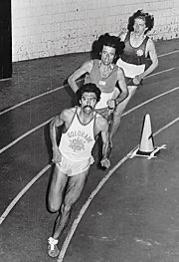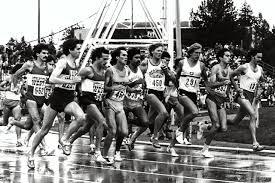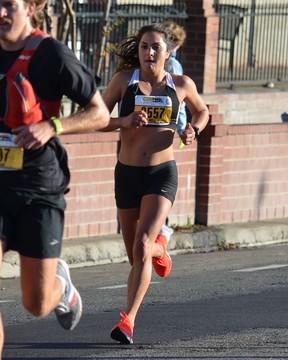 Sporting his trademark mustache, Ric Rojas leads Olympic Champion Frank Shorter, and Stan Mavis, at an Indoor Race, photos courtesy of Rojas Running
Sporting his trademark mustache, Ric Rojas leads Olympic Champion Frank Shorter, and Stan Mavis, at an Indoor Race, photos courtesy of Rojas Running
Countdown To Atlanta – The Gospel To Marathon Success According To Ric Rojas – By Jeff Benjamin
During the 1970’s & 1980’s, catching runner Ric Rojas was no easy feat (Pardon The Pun!). A National ranked High School Miler (With a 4:11 Mile PR BUT also a 4:12 Mile at 5000 feet at altitude!), Rojas rose to world-class status, winning the 1976 USATF National XC Championships ,setting the 15K Road Race World Record at Gasparilla in 1981, along with winning the first Boulder Boulder 10K, beating Olympic Champion Frank Shorter. Rojas was ranked among the top 10 US Road Racers from 1977 through 1981 by Track and Field News and competed in two Olympic Trials and two Pan American Games. Like others, one can say that the 1980 U.S. Olympic boycott affected many runners including Rojas.
Nowadays, Coach Rojas has once again approached an Olympic Trials competition, this time in the upcoming Marathon in Atlanta and as the Coach of his daughter Nell. Like his own career as a runner, Nell’s rise has been the product of patient and consistent training, which has led to her surprise breakthrough time of 2 hours, 28 minutes and 6 seconds, making her a potentially HUGE factor in the most unpredictable running event of all.
Coach Rojas’ Gospel is below:
“Nell has been training for the marathon unintentionally for the past 10 years with her professional-level triathlon, road-racing, Obstacle Course Racing (OCR), and aggressive strength work, but ran her first marathon only 18 months ago at the 2018 Cal International (CIM).
Her intention with her first marathon was to prepare for an Ironman Triathlon sometime late 2019. But, after her 2:31:21 at CIM, she abandoned her Ironman plans and shifted her focus to the 2020 Olympic Marathon Team Trials.
Her first significant “breakthrough” after CIM was winning the Bolder-Boulder Citizen’s Race 40 years after I won the first Bolder-Boulder in 1979 where I defeated Frank Shorter by 24-seconds. The Bolder-Boulder was an important confidence builder for her next race, Grandma’s Marathon in late June, 2019.
Nell approached Grandma’s with a conservative race plan but made good decisions as the race developed. She listened to her body, ran conservatively in the first half (1:15), but ran a big negative in the second half (1:13), pulling away and winning her second marathon, in 2:28:06, easily making the Olympic “A Standard” (2:29:30) and winning by 5 minutes.
Our plan after Grandma’s was to train for shorter races – less than 12k to develop leg speed for the Olympic Trials. She ran a decent Falmouth in August, finish 8th, one place ahead of Des Linden, then a 16:45 5K at the US National 5K Championships in September. She finished her year with a 4th place at the Manchester 5-miler on Thanksgiving Day, 2019. This was actually her best race. She finished 4th by 1-second and only 14 seconds out of first place.
Historically, she has run a Half-Marathon 6-weeks before her only 2 marathons. Before her CIM (2:31), she ran 1:16 and before Grandma’s (2:28) she ran 1:14. Her marathon times in her only two marathons were basically her half-marathon time x 2: 1:15:45/2:31:21 and 1:14:30/2:28. She ran 1:10:45 at the 2010 Houston Half-Marathon in January, so according to her historical numbers, a 2:22+ may be possible, all other things being equal.
Nell’s training has not been perfect approaching the trials, but it has never been perfect. She worked full-time before her first two marathons, but still managed strong efforts. Recently, she has been able to scale back her work schedule and her training volume and times have definitely improved.
For Nell’s entire career, we have been committed to a balanced approach to training – moderate but effective mileage, infrequent marathon racing, high-intensity interval training, frequent highly competitive shorter races, consistent aerobic cross training, and continued aggressive strength training. We have stuck to our guns, focusing on relatively low-mileage and high intensity.
Recently, I related to Nell that Gold Medalist Frank Shorter focused on speed intervals, competitive short races, and high-quality long runs. She had a chance to corroborate my observations when she met Frank at a local runners’ gathering this winter, and asked him if this was true. He answered in the affirmative, emphasizing his specific preparations were much more conservative than the training of contemporary American runners who are currently running much slower than he did 40 years ago. He ran no more than 5 x 1-mile, intensive 200-meter reps, and frequent short races against world-class competition.
American marathoners have recently posted interval sessions such as 15 x 1-mile or 5 x 5K on social media. In my opinion, these are beyond excessive and not effective. A quick review of the IAAF lists show that only a handful of American women have run under 2:30 and only a few men have run under 2:15 for the marathon. In my opinion, American runners are over-training and have precious few marathon results to show for their efforts. We believe that such track or interval sessions are not necessary to run a good or great marathon, especially for women. Our approach is definitely more conservative and more along the lines of the training philosophy of marathon greats Frank Shorter, Bill Rodgers, Tony Sandoval.”
Rojas doesn’t hold back when it comes to developing young runners.
“Regarding advice to young runners and to their parents and coaches, I definitely do not encourage high achievement and the associated high-volume training for adolescents. Young bodies are simply not ready for the training levels and frequency of competition now commonly seen in middle and high school cross country and track.
The downside of over-achieving in endurance running at a young age are injuries such as lower-extremity and pelvic stress fractures, endocrine/thyroid disorders, and eating and reproductive system disorders. These are real and now endemic in high school running among girls. Unfortunately, some of these disorders are invisible to coaches and sometimes even to parents, yet girls are encouraged to train more and harder as their personal health suffers.
Specifically, I would recommend low-mileage training programs – 12 to 20 miles per week of actual running, infrequent racing – 4 or 5 cross country races per season and only one or two track event per meet in the spring, more speed work and cross-training, and shorter cross-country race distances – 2 miles or even 1 mile – with only a few 5K’s each season.
A good example of high-frequency-racing-at-too-long-a-distance is high school cross country in the United States, which is the only running sub-culture in the world that has adolescents racing the exact same distance every week for 10-weeks straight. If I were to ask any high school coach/distance runner if he or she were to plan such a season for themselves – the same racing distance once or even twice a week for two months – they would certainly think I was crazy, yet this is exactly what they expect from their young athletes.
Furthermore, the 5K cross country distance heavily favors milers/two-milers at the expense of 400/800-meter runners or even sprinters. Shorter races would accommodate runners who do not have a fall running season, but who would love to participate/be competitive.”
Author

Jeff Benjamin has written for 30 years for American Track and Field along with RunBlogRun. The Former President of the Staten Island AC & Chair of the Staten Island Running Association was the 5th man scorer for his Susan Wagner High School NYC XC City Championship team. Also a member of the College of Staten Island Sports Hall of Fame for XC, Jeff currently serves as the LDR Chairman for USATF NY. A passionate (or fanatical) follower of the Sport, some of Jeff's subjects have included Sebastian Coe, Emma Coburn, Eamonn Coghlan, Matt Centrowitz, Jim Spivey, Galen Rupp, Joe Newton, Tom Fleming, Ajee’ Wilson, Bill Rodgers, Allan Webb, Abel Kiviat, Jordan Hassay, Marty Liquori, Caster Semenya, Rod Dixon, Carl Lewis and Jim Ryun as well as Book Reviews and articles covering meets and races in the Northeast U.S.
View all posts






















